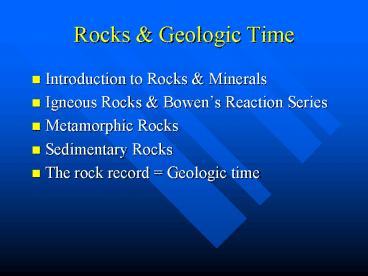Rocks - PowerPoint PPT Presentation
1 / 25
Title:
Rocks
Description:
Chemical and Clastic Sedimentary Rock. Rocks are layered. Chemical Sedimentary Rocks ... Clastic Sedimentary Rocks include Sandstone, Shales, Mudstones, Conglomerates. ... – PowerPoint PPT presentation
Number of Views:77
Avg rating:3.0/5.0
Title: Rocks
1
Rocks Geologic Time
- Introduction to Rocks Minerals
- Igneous Rocks Bowens Reaction Series
- Metamorphic Rocks
- Sedimentary Rocks
- The rock record Geologic time
2
Minerals
- Naturally Occurring
- Inorganic
- Solid
- Crystalline Structure
- Definite Chemistry
- Distinguishing are chemistry and structure
3
Why Should you Care?
- It is impossible to make it through a single day
without the use of a Geologists work. - Everything (including you!) is made up of
minerals or elements taken from the Earth. - You may not like geology or rocks or minerals,
but you cannot escape them!
4
Which of the Following are Minerals?
- Coal?
- Salt?
- Ice?
5
Coal
- It is naturally occurring
- It is solid
- It has a definite chemistry
- It has a crystalline structure
- It is NOT inorganic
- Therefore COAL is NOT a mineral
6
Salt?
- It is naturally occurring
- It is solid
- It has a definite chemistry
- It has a crystalline structure
- It is inorganic
- Therefore SALT IS a mineral
7
Ice?
- It is naturally occurring
- It is solid
- It has a definite chemistry
- It has a crystalline structure
- It is inorganic
- Therefore ICE IS a mineral
8
Most Common Elements in the Crust of the Earth
- Oxygen (O2-)
- Silicon (Si4)
- Aluminum (Al2)
- Iron (Fe2,3)
- Calcium (Ca2)
- Sodium (Na)
- Potassium (K)
- Magnesium (Mg2)
Silica Tetrahedra
9
Minerals make up Rocks
- Rocks are simply aggregates of one or more
minerals. - Three types of Rocks
- Igneous Born of Fire
- Metamorphic Born of Change
- Sedimentary Born of Dirt
10
Igneous Rocks
- Formed when minerals and other rocks melt
- Are classified according to their chemistry and
texture - Bowens Reaction Series Explains all there is to
know
11
Texture of Igneous Rocks
- Texture describes how the minerals fit together
in a rock and their size - Fine-grained are usually volcanic rocks
- Coarse grained are commonly plutonic rocks.
12
Definitions
- Plutonic Intrusive (magma stays underground)
- Volcanic Extrusive (magma flows to the surface)
- Lava Magma that has reached the surface.
13
Geothermal Gradient
- Why do rocks melt?
- Because the earth is hot inside!
- The change in temperature with increasing depth
is called the Geothermal gradient.
14
(No Transcript)
15
What Happens When Rocks Melt?
- They expand which causes.
- The density to decrease (because you have the
same amount of rock in a larger volume) which
causes.. - The melted rock to rise toward the surface!
16
Bowens Reaction Series (Chemistry of Igneous
Rocks
17
Additional Notes on Bowens
- As SiO2 increases density decreases.
- As SiO2 increases melting temperature decreases.
- As SiO2 increases crystallization temperature
decreases. - As SiO2 increases viscosity increases.
- As SiO2 increases explosive potential increases.
18
Trivia Question
- What type of magma comes from the volcano at Mt.
St. Helens? - What type of magma comes from the volcanoes in
Hawaii?
19
More Interesting Trivia
- Why are continents, continents?
- Why are oceans, oceans?
- Answer
- Continental Crust Thick and Light (2.7)
- Oceanic Crust Thin and Heavy (2.9)
20
Metamorphic Rocks
- Metamorphic rocks change shape or texture due to
- Pressure
- Temperature
- Chemical Conditions
21
Metamorphic Rocks
- Deformation of rock on a large scale is called
REGIONAL METAMORPHISM - Smaller scale metamorphism due to hot fluids is
called HYDROTHERMAL METAMORPHISM - Smaller scale metamorphism due to hot rock
encountering cold rock is called CONTACT
METAMORPHISM
22
Sedimentary Rocks
- Born of Dirt (sediment)
- Other rocks break down and are transported,
buried and cemented. - Chemical and Clastic Sedimentary Rock
- Rocks are layered.
23
Chemical Sedimentary Rocks
Halite (Rock Salt) Precipitated from
Seawater Limestone CaCO3 Precipitated from
Seawater Dolomite CaMg(CO3)2 Altered limestone
24
Biogenic Sedimentary Rocks
Coquina Shell fragments w/calcite and phosphate
cement Castillo de San Marcos- Built of Coquina
Washington Oaks Gardens Coquina
25
Clastic Sedimentary Rocks
Clastic Sedimentary Rocks include Sandstone,
Shales, Mudstones, Conglomerates.































